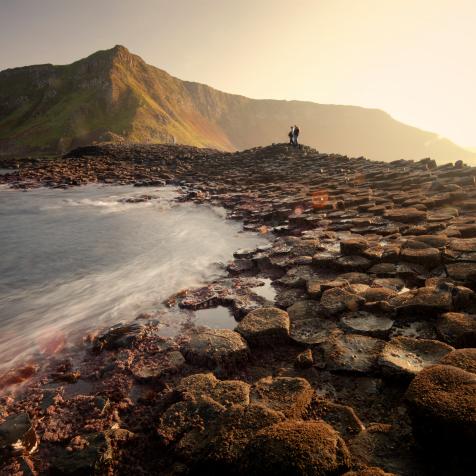
Getty Images/Loop Images
5 Magical Reasons to Visit Iceland
Be prepared to be wowed by this unique island country.
The name itself conjures up an image of a land of imposing ice formations, and while that isn’t too far off, Iceland is more than just arctic temps and shining glaciers. Don’t let the cold deter you: Iceland might be almost at the top of the world, just below the Arctic Circle, but its winter temperatures are often warmer than those in New York (and it's only a 5-hour plane ride from New York, too).
While its dramatic, otherworldly natural wonders, especially the northern lights, are nothing short of magical, there are many more reasons you’ll be enchanted on a visit to Iceland. So pack your (faux) fur-trimmed hat and prepare to be wowed by this unique little island country.
1. Superjeep

Ed Norton / Getty Images
Iceland is one of the best places in the world to witness the wonder that is the northern lights. If you’re lucky, you’ll catch the mystical green lights dancing in the sky on a cold, clear winter night. While it might be more fun to believe that the northern lights are pure magic, the phenomenon of aurora borealis can be explained scientifically as the result of the upper atmosphere being blitzed by highly charged electrons from the solar wind. Like we said, let’s just call it magic.
The hunt for the elusive northern lights can be even more memorable than actually witnessing the seemingly supernatural show. Bundle up for an adventurous 4x4 Superjeep excursion searching for the best nightly sighting, or test your luck waiting for the lights to appear on your evening dip in one of the country’s many geothermal pools.
2. Arcanum Glacier Tours

Oscar Bjarnason / Getty Images
Steaming geysers, drifting icebergs, black lava beaches, erupting volcanoes — you’ll find them all in Iceland, and sometimes within a half-hour’s drive of one another. The country has more than 4,500 square miles of glacier, so you can’t visit without walking on ice in some way. Take a walking or ice-climbing tour on the Solheimajokull glacier on the south coast of Iceland. Or take a self-guided driving tour of Ring Road, the main national route that circles the country, to see even more natural wonders at your own pace, including the Eyjafjallajokull volcano, the Jokulsarlon glacier lagoon, the East Fjords and the impressive Dettifoss waterfall. Keep an eye out for the Icelandic horses, a unique, pony-size breed known for its sure-footedness in rough terrain and its ability to evoke the moodiness of Iceland with shaggy hair covering its eyes.
3. Harpa

Arterra / Sven-Erik Arndt / Getty Images
Known for its avant-garde design and bubbling creative energy, Iceland offers plenty of inspiration in its dramatic landscapes and natural wonders. One of the most prominent examples of this is Harpa, the dazzling concert hall and conference center with a glass-block facade that glitters and changes color on the Reykjavik Harbor. Artist Olafur Eliasson designed the facade to evoke a glacier’s interplay with light. Home of the Iceland Symphony Orchestra and the Icelandic Opera, Harpa also has hosted performances for Iceland Airwaves, the annual music festival that draws some of the world’s top musicians of the moment. Iceland’s most renowned musicians have also performed here, including Sigur Ros, Bjork and Of Monsters and Men.
4. The Elf School

bravobravo / Getty Images
While it might cause tourists to snicker, the belief in elves — huldufólk, or hidden folk, as they’re more commonly referred to — is no laughing matter for Icelanders. In a survey from 2006, 37% of Icelanders said they believe that elves possibly exist. The belief is so much a part of their culture that roads and construction projects have been altered or halted so as not to disturb the hidden folk, and many families even have small wooden alfhol (elf houses) in their gardens.
While visitors might notice that Icelanders are not willing to discuss their beliefs, there is a place where your questions are encouraged: the Elf School in Reykjavik. There, you can learn all about the mystical creatures — including 13 types of elf, 4 kinds of gnome, 3 species of troll and 3 varieties of fairy — from Icelanders who claim to have had personal contact with the hidden folk. The most important rule you’ll learn: Never cross an elf by throwing rocks; it might disturb his home.
Some skeptics, even the current president, say that Icelanders invented the hidden folk to keep them company during long, cold winters (it is one of the least-densely populated nations on the planet), but there’s no doubt that the folklore is an integral part of the country’s cultural fabric.
5. Blue Lagoon Spa

Jonathan Percy / Getty Images
A dip in the Blue Lagoon’s steamy water is on many bucket lists, and for good reason. What’s not to love about crystal-blue, geothermal water that hovers between 98 and 102 degrees year-round with views of spectacular, snow-covered lava rocks in every direction? After spending an entire day soaking in the Blue Lagoon, you’ll emerge feeling like a new person — and looking like one, too. The sulfur- and silica-rich water is known for its natural, age-defying healing powers.
Geothermal energy heats up more than the Blue Lagoon; in Iceland, it heats and powers homes, baths and pools, public as well as private. Bathing in communal thermal baths is a popular part of daily life — unwinding after a long day or catching up with the latest gossip and news. Escape the tourists and experience this part of the local culture at the geothermal-heated swimming pool Laugardalur Park, outside downtown Reykjavik, just one of many places in Iceland to offer natural hot tubs, or "hot pots.”
Who knows? You might even hear the latest gossip on the hidden folk.


















